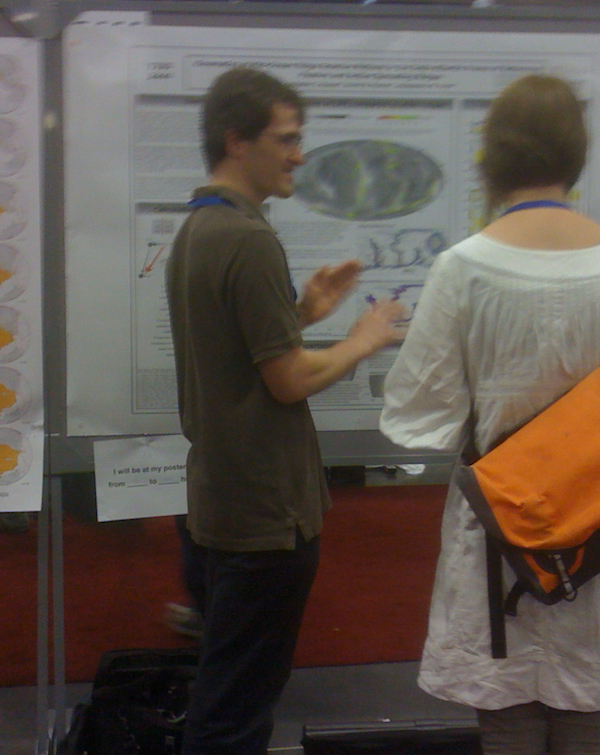![]() Anne: So, Chris – how did your poster session go?
Anne: So, Chris – how did your poster session go?
![]() Chris: It went pretty well. The two key things that you want from a poster session are that you spend more time talking to people than you do standing and staring hopefully at everyone wandering past, and that the people you talk to don’t find glaring, basic flaws in the scientific story that you’re trying to present. Most people seemed to think that I had an interesting story about global ridge motions and how the EPR is fixed in the mantle, and I still had my voice at the end of it all. So I’m pretty satisfied.
Chris: It went pretty well. The two key things that you want from a poster session are that you spend more time talking to people than you do standing and staring hopefully at everyone wandering past, and that the people you talk to don’t find glaring, basic flaws in the scientific story that you’re trying to present. Most people seemed to think that I had an interesting story about global ridge motions and how the EPR is fixed in the mantle, and I still had my voice at the end of it all. So I’m pretty satisfied.

Chris discusses his poster. Camera angle cunningly chosen to hide confused look on the face of his audience.
Anne: And did you get to those talks you wanted to see this afternoon during your poster session?
Chris: I got to the Gutenburg Lecture just after lunch. Thorne Lay gave a great overview of how seismic and geodetic data from continuous GPS receivers are being combined to great effect in studies of large subduction zone earthquakes, like the 2004 Sumatra earthquake and this years Tohuku earthquake off Japan (what he called ‘seismo-geodesy’). It was quite fun for me because a lot of the earthquakes he talked about were quite familiar to me through my blogging about them.
Sadly, a lengthy discussion at my poster prevented me from attending the rock magnetism talk I was planning to go to at the end of the day. By the time I’d finished talking, the lecture had already been going for 15 minutes.
Anne: Yeah, I know what you mean. I missed a whole hour of talks I meant to see, but had really good, useful conversations in that time instead. I’m starting to think that the poster hall has a serious gravity well associated with it. Every time I think I’m going to escape its orbit and go and listen to some talks in Moscone West, I get sucked back into the vortex by just one more interesting poster, or an encounter with a long-time acquaintance.
Chris: So any highlights from the poster hall vortex?
Anne: I had a couple of really good discussions about linking topographic form of watersheds to the geomorphic processes that shape them, which is directly related to the talk I’m giving tomorrow morning, so it was helpful to see what other people were thinking and doing in places ranging from endorheic basins in Chile to the mountains of Idaho.
But the definite highlight of my time in the poster vortex was running into a former undergraduate student of mine, who took my very first offering of hydrogeology. Now he’s completing a Masters degree in hydrogeology.
Chris: Very cool. My adventures in the vortex centered around the tectonics of subduction zones – particularly what happens when you try to subduct things like ridges and seamounts. I also had a good discussion of new data being collected along the Hikurangi subduction zone off New Zealand, which is a long-standing interest from my PhD research. But I did finally escape to Moscone West, where I sat in on an interesting series of talks about the role of tectonic inheritance in determining the structure of mountain belts. I’d never really appreciated this before, but if a continental collision is the end result of an ocean basin closing, then that ocean had to have first opened up by rifting; and it seems that the structures that formed during that rifting are very important when you get to the mountain building stage. So to truly understand mountain belts, you have to think quite long-term.
And you managed to escape to see some talks today, didn’t you?
Anne: Yes. I spent a good chunk of the afternoon in a hydrology session on ‘Landscape system response under change’, which had talks on the intersections between hydrology, geomorphology and biology. I especially liked Ellen Whol’s talk on the influence that headwater stream geomorphology plays on carbon storage in coarse wood in the floodplain and channel and in fine sediment. Beavers may play an important role in the carbon cycle!! It got me wondering about ways that urban stream hydrology and geomorphology may influence carbon dynamics.
Actually, Chris, it was all about allochthonous materials – at least as I understand them!
Chris: Well, there’s at least one word I understand! Once again, we both had very busy days which had very little in common with each other. It just goes to show just how much is going on at AGU. Bring on Wednesday!
[NB: This is a repost. A server failure at our hosts meant the original was lost.]





Nice plan for content warnings on Mastodon and the Fediverse. Now you need a Mastodon/Fediverse button on this blog.